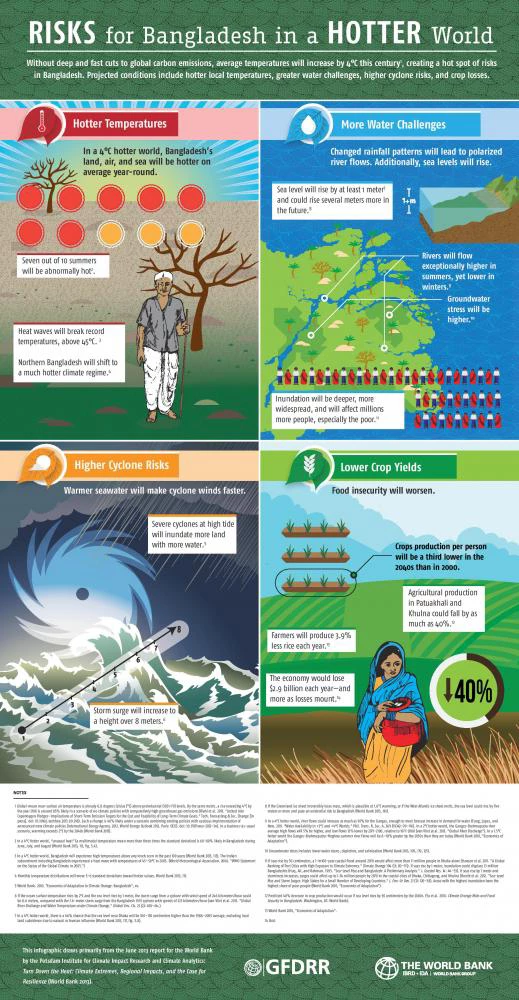
While many impacts of climate change are already evident around the world, the worse is still to come. Having a clear picture of future risks is essential to spur action now on a scale that matches the problem. The World Bank has prepared the following infographic to communicate the risks for one of the world’s most vulnerable countries—Bangladesh.
The data comes from the 2013 World Bank report Turn Down the Heat: Climate Extremes, Regional Impacts, and the Case for Resilience. This report combines a literature review and original scientific modeling to build on a previous effort that found that the world will become 4°C (7.2°F) hotter during this century in the absence of deep and fast cuts to global carbon emissions. In this scenario, hotter local temperatures, greater water challenges, higher cyclone risks, and lower crop yields will create a hotspot of risks for Bangladesh.
Bangladesh already has a hot climate, with summer temperatures that can hit 45°C. Heat waves will break new records in a 4°C hotter world, with 7 out of 10 summers being abnormally hot. Northern Bangladesh will shift to a new climatic regime, with temperatures above any levels seen in the past 100 years and monthly deviations five to six times beyond the standard.
New rainfall patterns will lead to polarized river flows, with flows exceptionally higher in summers yet lower in winters. In a country already prone to flooding (on up to two-thirds of its land area every three to five years) and drought (every five years), such a trend will only make matters worse. Groundwater stress will also increase, especially in coastal areas where salinity already affects 20 million people.
Higher, warmer seas will also produce more intense tropical storms. In 2007 Cyclone Sidr inundated the land of 3.45 million Bangladeshis, producing damages and losses equal to 2.6 percent of gross domestic product. A cyclone like Sidr (once in 10 years) would inundate 88 percent more land in 2050 than it would today and expose 9.7 million people to severe floods more than 3 meters deep.
Food shortages, already persistent in Bangladesh, will also worsen with climate change. Warming of 4°C will severely threaten crops, especially rice grown during annual monsoons. Yields will decrease despite any potentially positive effects of warming.
With the impacts of a hotter world already appearing, we don’t have to wait for more analysis to know that the time to act is now: both to mitigate climate change and to prepare for unavoidable impacts.
Click here to view the full size infograph.






Join the Conversation